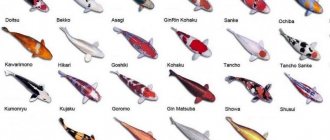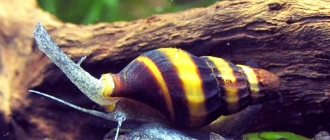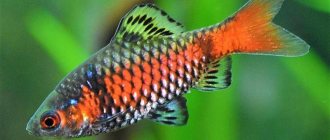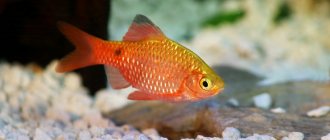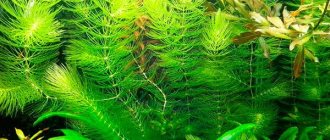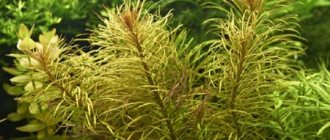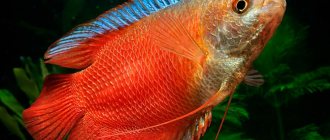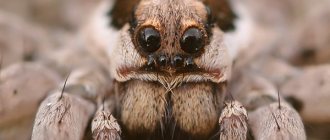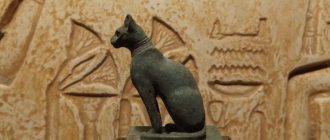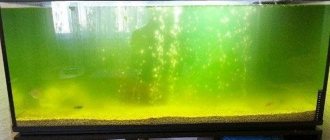Aulonocara species
Malawian cichlids are distinguished by pronounced sexual differences: only males are bright and beautiful. The female is always faded, and by the color of the male you can understand what species the representative belongs to. Describing the colors of each species is not an easy task. What all species have in common is the presence of many sparkling scales that glisten even in poor lighting.
- Aulonocara orchid, strawberry - a captive-bred variety, has a bright color with a predominance of rich red. The head up to the gill covers is bluish-pearl with red inclusions. Blue is found on the dorsal fin in the form of thin stripes and on the caudal fin in the form of round spots;
- Aulonocara multicolor is one of the popular breeding species. The main body color is orange from yellow to red. Closer to the tail, the scales are colored blue in places, making the color transition clearly visible. At a certain lighting angle, slightly darker transverse stripes appear. There are black spots of irregular shape throughout the body, including the fins. The fins themselves can be colored to match the body color or a contrasting blue shade;
- aulonocara nyasa, aulonokara queen nyasa - fish of a rich blue-violet color. Males have color transitions into red-blue and yellowish, closer to the anal fin they can turn almost black, females are uniformly blue with dark transverse stripes and lighter spots of irregular shape. The characteristic transverse stripes range in color from dark blue to black and may fade if the fish is frightened. The anal fin may have an orange-red border; the spinal fin most often has a light, almost white border;
- aulonocara bensha, golden queen - lemon yellow color predominates. There may be small blue spots throughout the body. The lower part of the head is bluish-pearl. The transverse stripes have a lighter shade compared to the entire body;
- Aulonocara red flash is a selection variety, similar to Nyasa, but the color does not turn black, and behind the gills the transition to red is clearly visible. The pectoral fins are also bluish-red, with a blue ray in front. The vertical stripes are dark, with a purple tint. The border on the dorsal fin is bluish-white;
- Aulonocara red ruby is a breeding form. There are two main body colors - red and blue. The body of the fish is red with purple transitions and transverse dark stripes. The head is blue, and the fins combine these two shades equally;
- Aulonocara mailanda is a blue fish with dark transverse stripes and a bright yellow stripe from the upper lip to the dorsal fin. In some, the yellow extends to the fin, forming an edge. Females are also blue, slightly paler and smaller;
- Aulonocara freiberga, the Malawian butterfly, is the largest representative of the species (can grow up to 17 cm). The color is similar to red ruby. The difference is in the luxurious fins. The dorsal is higher than that of other fish, with a clear figured edge, colored almost white. The caudal blade is forked: the rays are longer at the edges, gradually shortening towards the middle;
- aulonocara red dragon is a hybrid form, on a red background there is a small number of bluish streaks that sparkle in good lighting. The eyes are yellow;
- aulonocara stewart grant, stewartgranti - has several color variations: blue, yellow-greenish or with two shades - blue and orange. Blue fish have transverse dark stripes, a white edging on the dorsal fin and a reddish-yellow edging on the anal fin. The orange ones are noticeable by the dark blue head and the same fins, with a light blue edging on the dorsal fin. Mixed color: the lower part of the head is blue, the upper part is blue, this color extends to the tail along the back. The belly, lower half of the body and tail are orange, all fins are blue-blue;
- aulonocara rosea, aulonocara rose - a breeding form, painted in shades of pink with transitions from pale to rich colors and round spots on the fins.
Diseases
"Malawi bloat" is a common disease for aulonocaras, especially if they are fed poor quality food. The disease manifests itself as a bloated abdomen, the fish sinks to the bottom and does not swim. In this case, you need to reconsider the diet of the individuals.
Cichlazomas are susceptible to other common diseases, especially if the water is dirty, of poor quality and oxygenation. For example, white spot disease, which appears as crusts all over the body. To eliminate the disease, change 30% of the water and increase its temperature to 30℃ for 3 days.
How to keep aulonocara
The appearance of the fish is influenced by the conditions of detention, primarily the size of the aquarium. If the fish is placed in a small volume, it will not reach the peak of beauty and will not gain full color. How long do aulonocaras live in a home aquarium - up to 10 years with excellent maintenance and much less if care is insufficient.
Arrangement of the aquarium
- aquarium volume – for a school of fish 3-4 pieces – from 150 liters. The larger the volume, the more fish you can stock. An aquarium with cichlids is always alive, filled with movement, so a small volume is not suitable;
- a good solution would be fine sand or river soil 3-5 mm, the color does not matter, you can focus on the design features;
- The filter must be external, since the volume is large. The external filter copes well with contaminants, maintains water parameters and enriches it with useful elements;
- aeration – round the clock, quite active;
- It depends on the lighting whether the aulonokara will look advantageous. The beauty of the color is especially noticeable in diffused light, as well as in the rays of special lamps with shades;
- Artificial plants need to be firmly dug into the ground, as designer cichlids like to rearrange everything. Living plants are practically unsuitable for cichlids (with the exception of Vallisneria and Echinodorus), since most do not withstand constant excavations, grow poorly and die. Plants floating on the surface can be an excellent vitamin supplement to the fish’s diet;
- the decor necessarily includes stones, driftwood, caves.
Water parameters
- temperature 24-29°C;
- hardness 12-25°;
- acidity 7.6-8.6 pH;
Maintenance and care
- weekly change of a fifth of the water;
- cleaning the soil with a siphon 1-2 times a month.
Content
These cichlids are an excellent choice for both beginners and experienced aquarists. The fish are easy to care for, feed and are relatively undemanding to other inhabitants of the aquarium.
Requirements for an aquarium
- For one individual an aquarium of at least 150 liters is required; for a flock you will need an aquarium of 400 liters or more.
- The species needs good water movement as well as effective filtration.
- Create subdued lighting.
- Provide the aquarium with decorative objects to hide the fish. At the same time, be sure to leave enough space for swimming.
- Use sand or gravel as a substrate.
- You can plant an unlimited number of plants, since cichlids are indifferent to them.
Water requirement
- Temperature: 22.8-28.9℃.
- pH range: 7.8-8.6.
- Hardness: 10-18 dGH.
Both fresh and slightly brackish water are suitable for the species. Cichlids mainly consume protein foods, which creates additional stress on the filtration system. It is necessary to change from 20 to 50% of the water per week.
What to feed?
— Advertising —
Although Aulonocara bensha is an omnivorous fish. However, her priority is protein foods. If there are plants in the aquarium, the fish will not touch them. In the wild, individuals feed on a wide variety of living foods, especially small invertebrates.
In the aquarium, feed them meat treats, frozen and freeze-dried daphnia, worms and shrimp. Avoid tubifex worms as they contribute to a condition called Malawi bloat.
Feed the fish 5-6 times a week.
What to feed
For predators, the basis of the diet is live food: bloodworms, pollock fillets, and shrimp. You can feed both fresh and frozen food.
In addition to protein foods, plant supplements in the form of dry food, flakes and granules are needed. There are special mixtures for maintaining the color of Malawian cichlids that are perfect for Aulonocaras.
The food can be alternated. Adults are fed once a day, young animals can be fed twice. Be sure to measure portions: if food (especially dry food) settles to the bottom, the fish most likely will not collect it, and this will negatively affect the water parameters.
Habitat in nature
Aulonocara Bensch was first described in 1985. It is named baenschi in honor of Dr. Ulrich Bensch, founder of Tetra.
Endemic to Lake Malawi, they are found near Maleri Island, Chipoka, Nkohomo Reef near Benga. There are a total of 23 species of Aulonocara, although there are many subspecies.
It lives at a depth of 4-6 meters, but is also found at greater depths, often 10-16 meters. They can live both in caves and form large flocks. As a rule, each male has his own territory and shelter, and females form flocks.
They feed on various insects, which they search for and dig in the sandy bottom. To search for food, they have developed special sensitive pores on their jaws. They serve as a kind of sonar, helping to determine the noise from the entrenched larva.
As soon as the victim is discovered, she grabs it along with the sand. The sand is then spat out through the gills and the insect remains in the mouth.
Behavior and Compatibility
Aulonocaras are distinguished by high intelligence, the ability to get used to the owner and recognize him. They love to dig in the ground and rearrange stones to suit their taste, so the aquarist sometimes has to work hard to keep the aquarium not only clean, but also beautiful.
Aulonocaras, ready to reproduce, occupy a hole, cave or depression, and become aggressive towards their neighbors. If there are a large number of individuals, there should also be enough minks so as not to provoke fights for territory.
Intraspecific compatibility is allowed: aulonocara of different characters get along well with each other in sufficient quantities. Some fish are more aggressive, others, on the contrary, are calm and peaceful. If there is enough shelter in the aquarium, fish with different personalities will coexist successfully. It is better to stock cichlids at the same time so that they grow together. The team may not accept a newcomer.
Neighbors may include catfish (pterygoplichts, ancistrus) and other Malawian cichlids of similar size. The average size of an adult aulonocara is 13-15 cm.
Compatibility with other fish species
When keeping different types of fish in one aquarium, it is necessary to take into account not only the nature, but also the conditions of their keeping and the food used. For example, cohabitation of multicolor and pseudotropheus is undesirable. Although both fish are peaceful, their diet is nevertheless different. So, if Pseudotropheus eats meat (and it feeds exclusively on plant foods), the fish can get indigestion. That is why the compatibility of Aulonocara multicolor and Pseudotropheus is very low.
Acara is a peaceful fish , so keeping it with aggressive cichlids is not the best option.
The most suitable neighbors should be peaceful and the same size as Aulonocara multicolor. Experienced aquarists recommend choosing labidochromis yellow, copadichromis “Kadango”, blue ackee or blue dolphin as cohabitants.
Aquarium fish are absolutely incompatible with Haplochromis cornflower and aggressive species of cichlids.
Breeding and reproduction
Aulonocara cichlids successfully breed at home in a community aquarium. Sexual maturity occurs at 10-12 months in females and 12-15 months in males. It is noteworthy that a male can reach full color later than sexual maturity. The color reveals itself at about 2-2.5 years. It is permissible to keep 2-3 females per male.
The courtship period is short, the female lays eggs, the male fertilizes her, after which the female carries the eggs in her mouth. The incubation period is 2-3 weeks, during which time the female does not release the future offspring from her mouth, which is why she rapidly loses weight. When the fry are able to swim independently, they come out into the light, but stay close to their parents. At the slightest threat, they return to the most reliable shelter - the mother's mouth.
Having reached a sufficient size, young fish begin to swim independently. If obtaining offspring was not the main goal, you can leave the spawning pair in a common aquarium, where the most agile and cunning fry will survive. The weak and sickly will be eaten. If quantity is important, it is better to place the female and the fry in the spawning tank.
Maintenance and care, arrangement of the aquarium
To successfully keep a small group of adult fish, you will need a tank of at least 200 liters. The design uses several large stones/rocks or other decorative elements, a sandy substrate and unpretentious plants, for example, Anubias, Vallisneria, Arrowhead subulate and the like. Water conditions have high pH and dGH values. Placing a productive filtration system along with weekly replacement of part of the water with fresh water (15–20% of the volume) will allow maintaining hydrochemical conditions at the proper level. It is advisable to purchase filters with filter materials that increase water hardness to avoid strong fluctuations in dGH.
It is worth remembering that the soil should only be sandy; fine gravel and pebbles can get stuck in the mouth or gills when the fish feeds.
General characteristics and gender differences
Aulonocaras (aka “African acars”) are tropical freshwater fish that belong to the Cichlid family (order Perciformes).
In the wild they are found on the sandy shallows of lakes located in eastern Africa, however, in addition to natural species, today there are also several artificially bred ones that live exclusively in home aquariums.
Learn more about members of the cichlid family.
Depending on the specific species, the body length of aulonocara ranges from 8–20 cm, and their characteristic difference is the clearly visible indentations on the head (it is believed that they play an important role in the sense of space).
Among other features of the appearance of aulonocar, it is worth highlighting:
- elongated body;
- high back;
- large and slightly angular head;
- long dorsal fin.
Females are traditionally smaller than males, have rounded dorsal and anal fins and yellow-gray scales with vertical stripes. The color of the fry resembles that of the females, but with age the males become much brighter, predominantly blue or blue with a metallic sheen.
Important! Among the hybrid species of aulonocara there are fish of turquoise, pink, sky and even black colors, and the color of the males is fully formed only closer to the age of two.
In some areas of the body the color is more matte, cherry or lemon tones. The fins of these aquarium fish are always bright: usually blue, yellow or light blue, and a light border may be observed on the upper edge of the dorsal fin. The anal fin often has small orange or yellow spots.
